Microbiology Advent Calendar 2022
We have had a lot of great feedback from our clients about the Microbiology Advent Calendar we ran on social media in December so we have uploaded all of the images and details below for you to take a look at!
DAY 1
🎄🎁Welcome to day 1 of December and to the start of our advert calendar! 🎄🎁
Today’s plate shows Pseudomonas aeruginosa on a Pseudomonas Agar Base!
Pseudomonas aeruginosa is a common type of bacteria usually found in soil and water. It can be difficult to treat as it doesn’t always respond to antibiotics, and it can also contribute to biofilm formation in water systems. For this reason, it is often referred to as a ‘superbug’.
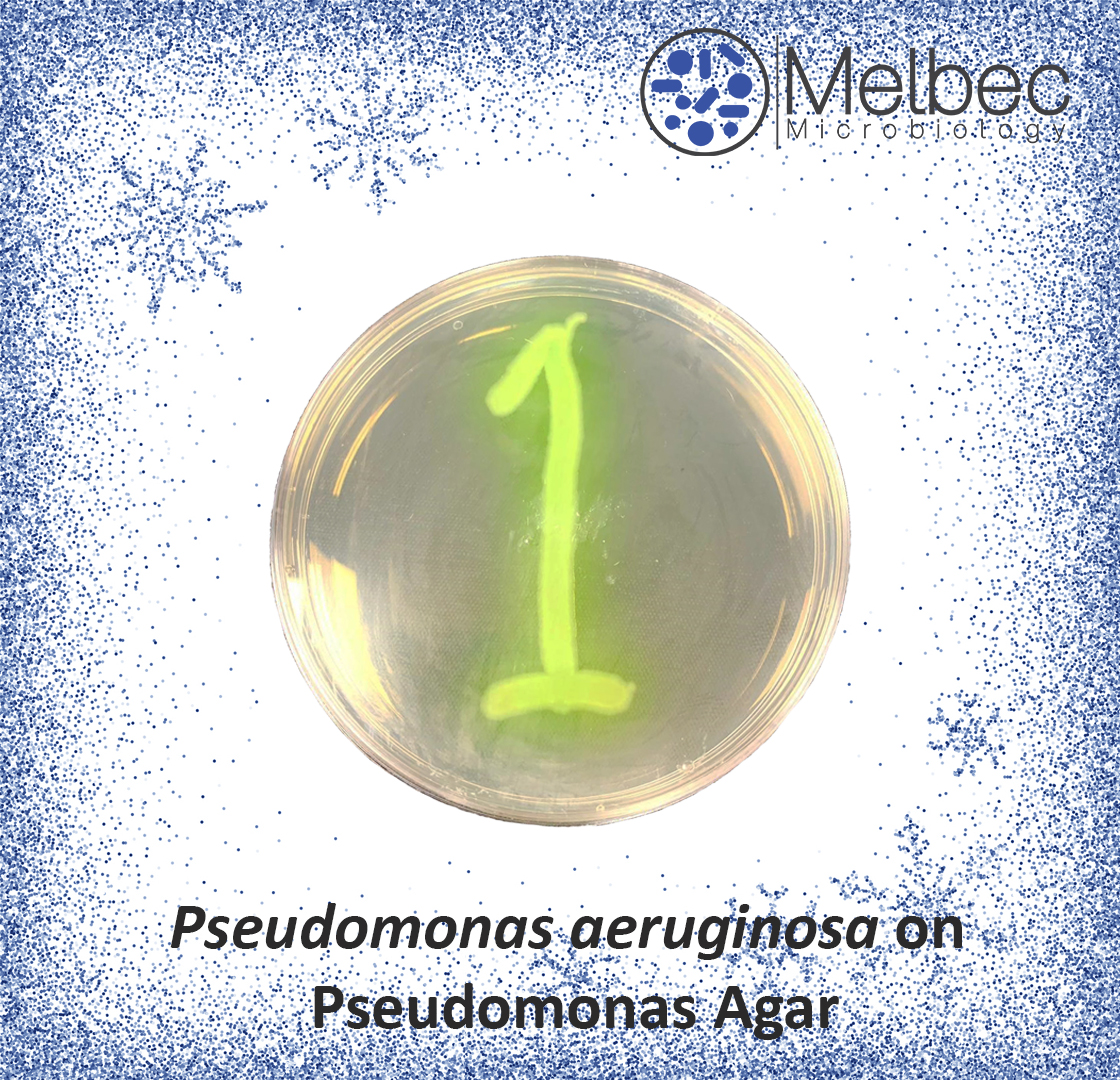
DAY 2
🎄🎁 Happy Friday and it’s Day 2 of December! 🎄🎁
Today’s plate shows Legionella pneumophilia on a Buffered Charcoal Yeast Extract (BCYE) Agar.
Legionella pneumophilia is a bacterium associated with illnesses including Legionnaires’ disease and Pontiac fever. It is commonly found in natural water sources like rivers, lakes, and reservoirs, usually in low numbers. However, it is also associated with purpose-built water systems such as cooling towers, evaporative condensers, spa pools and hot & cold-water systems, where water is maintained at a temperature high enough to encourage growth. In these cases, the risk of infection is increased.

DAY 3
🎄🎁 Day 3: Klebsiella on MacConkey (MAC) agar! 🎄🎁
Klebsiella is a genus of Gram-negative bacteria, named after German-Swiss microbiologist Edwin Klebs. The bacteria can cause various types of healthcare-associated infections, including pneumonia, bloodstream infections and meningitis. Klebsiella is normally found on the human body as part of the normal flora, where they do not cause disease.
However, it is known as an opportunistic pathogen as can cause infections to those requiring devices such as ventilators or IV catheters. MacConkey (MAC) agar is a selective and differential agar designed to isolate bacteria based on their ability to ferment lactose, and can be used to culture Klebsiella spp., which develop pink colonies when grown on this agar type.

DAY 4
🎄🎁 Day 4: Lactobacillus on De Man, Rogosa and Sharpe (MRS) agar! 🎄🎁
Lactobacillus is a genus of Gram-positive bacteria which is a significant component of human and animal microbiota within the digestive system. It produces lactic acid, which can help to break down lactose, a sugar found in milk. Lactobacilli are known to protect its host against potential invasion of pathogens and is therefore strains such as Lactobacillus acidophilus are often used as probiotics. They are commonly found in foods such as yogurt and Kefir and can improve gut health and help to treat and prevent infections.
De Man, Rogosa and Sharpe (MRS) agar has been developed specifically as a selective agar for the isolation and cultivation of Lactobacilli.
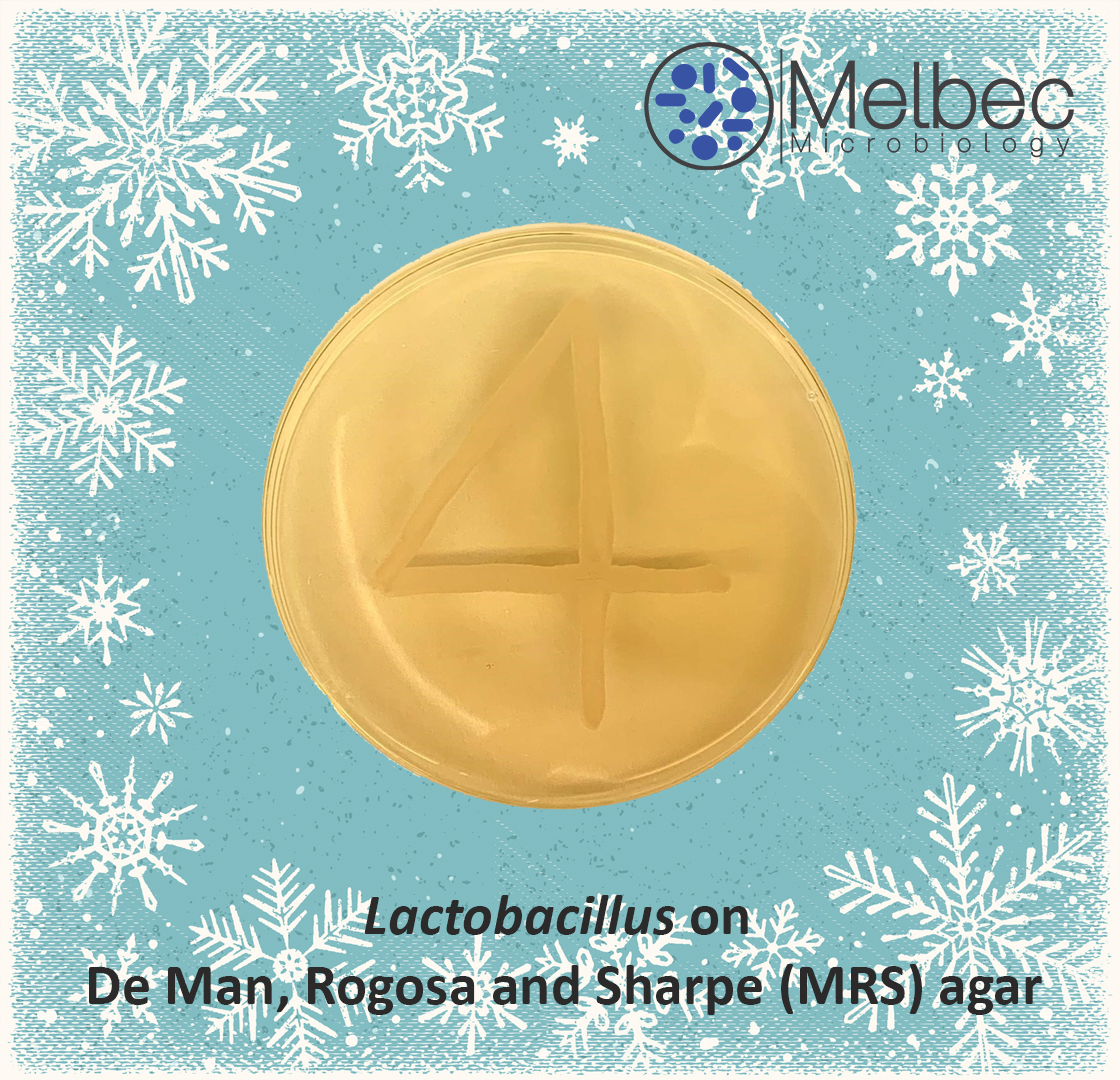
DAY 5
🎄🎁 Welcome to Day 5 of December! Today’s plate is E.coli on Violet Red Bile Glucose Agar (VRBGA)! 🎄🎁
Escherichia coli is a Gram-negative bacteria commonly found within the environment, foods and the intestines of humans and animals. E. coli are a large and diverse group of bacteria, with most strains being harmless, whilst others can make you ill. E. coli infections are often associated with food poisoning caused by the consumption of contaminated vegetables, raw or undercooked meat.
Violet Red Bile Glucose Agar (VRBGA) is used for the enumeration of Enterobacteriaceae in foods, including E. coli strains, which will grow pink colonies as they are able to ferment the glucose within the media.
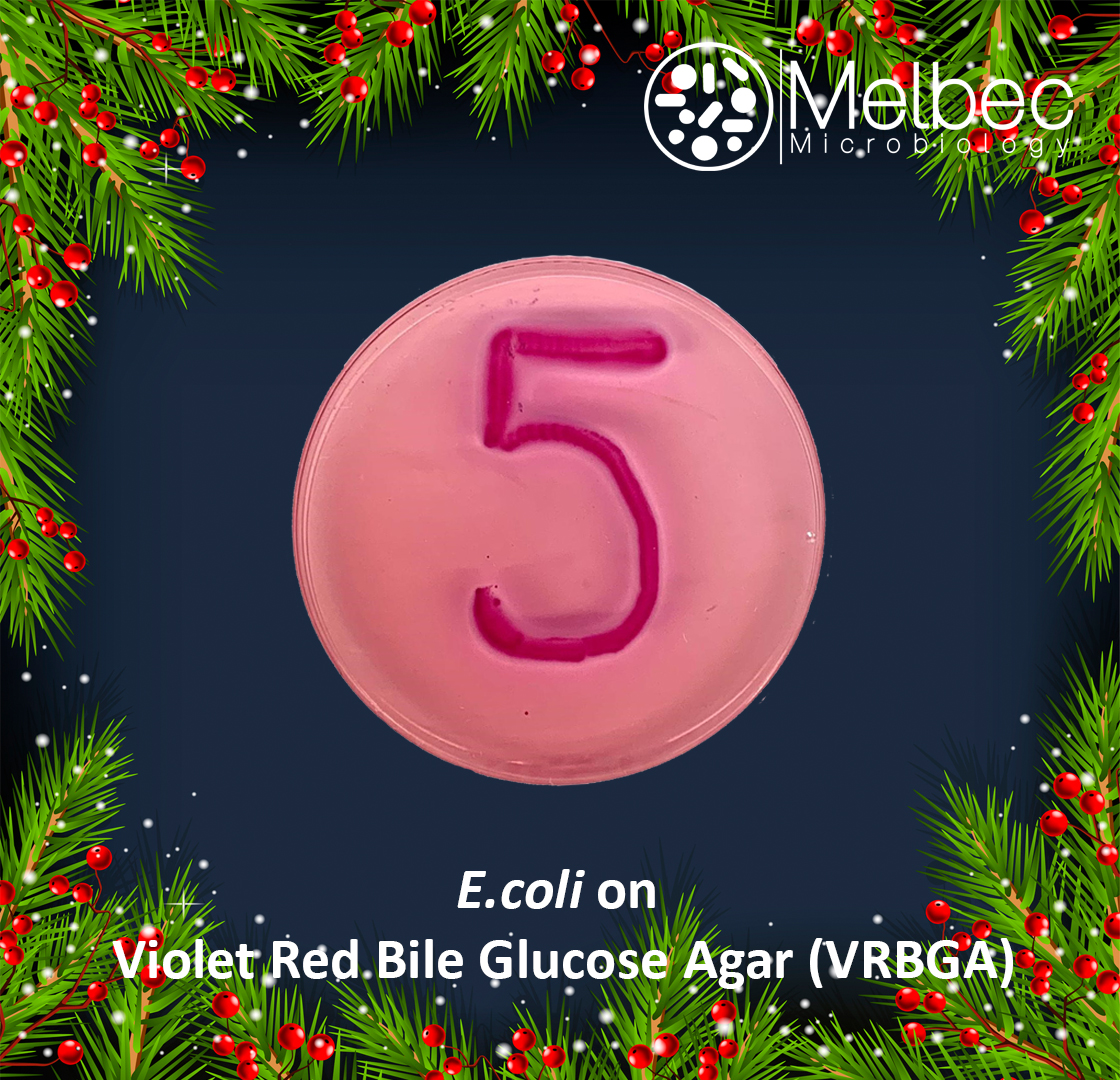
DAY 6
🎄🎁Day 6: Coronavirus🎄🎁
A virus is an infectious microbe consisting of a segment of nucleic acid (either DNA or RNA) surrounded by a protein coat. A virus cannot replicate alone; instead, it must infect cells and use components of the host cell to make copies of itself. Coronaviruses are a group of related RNA viruses that can cause diseases in mammals and birds.
Coronaviruses are large, roughly spherical particles with unique surface projections, measuring between 80 to 120 nm on average. In humans, they cause respiratory tract infections that can range from mild to lethal. More lethal varieties include SARS, MERS and COVID-19, the cause of the ongoing pandemic.
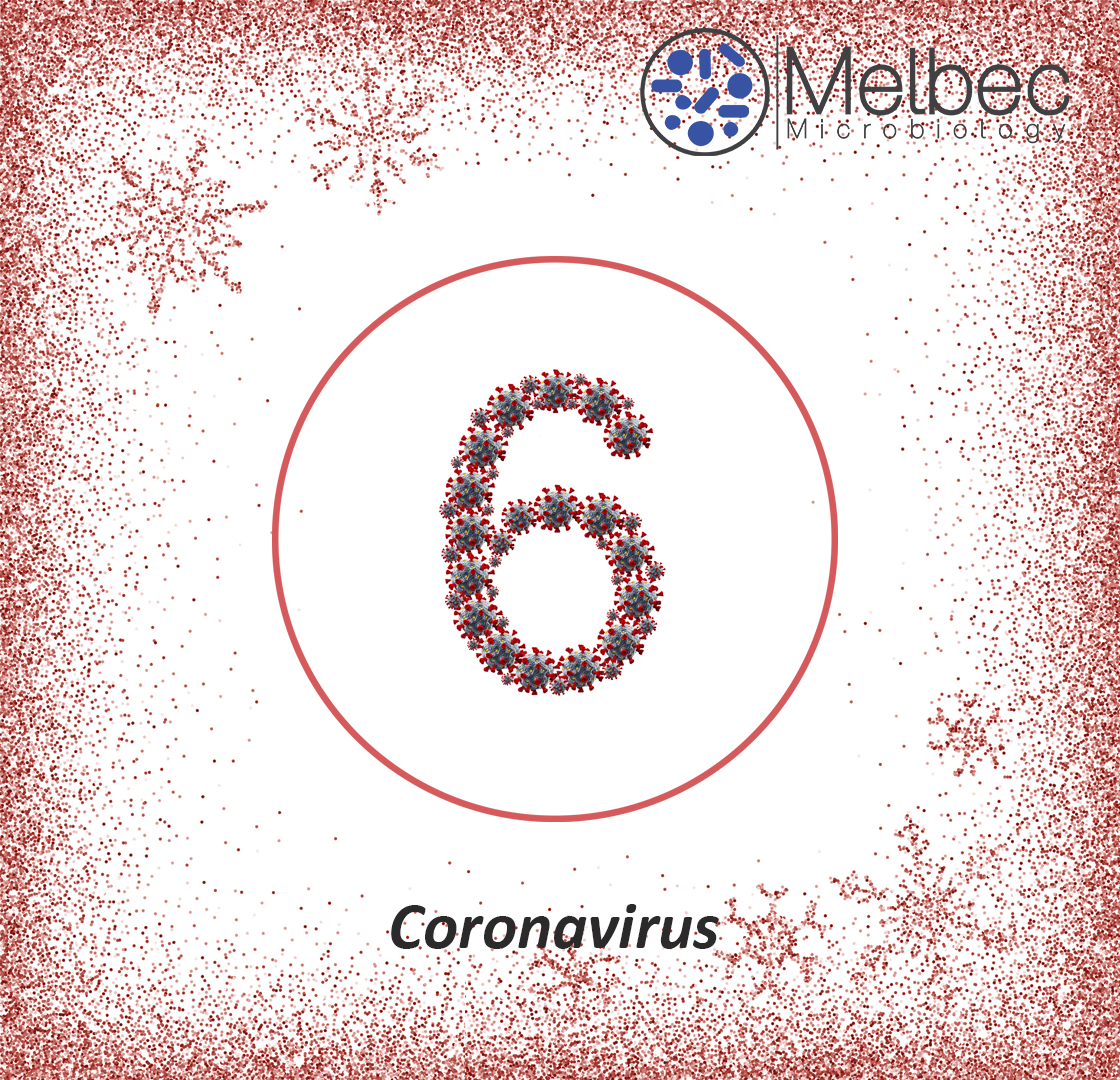
DAY 7
🎄🎁Day 7: Streptococcus on Blood🎄🎁
Streptococcus is a genus of Gram-positive spherical bacteria and are commonly associated with infection of the throat (strep throat), pink eye, endocarditis, and necrotising fasciitis (the ‘flesh-eating’ bacterial infections). Not all strains are pathogenic, and some form part of the natural microbiome of the mouth. Streptococci are also a necessary ingredient in producing Emmentaler “Swiss” cheese.
Species of Streptococcus are classified based on their haemolytic properties (the breakdown of blood cells), and therefore are often grown using a general-purpose culture media supplemented with blood.
EDIT: This advert calendar was set up prior to the current outbreak of Strep A. Our thoughts are with the families who have lost their children to this organism.
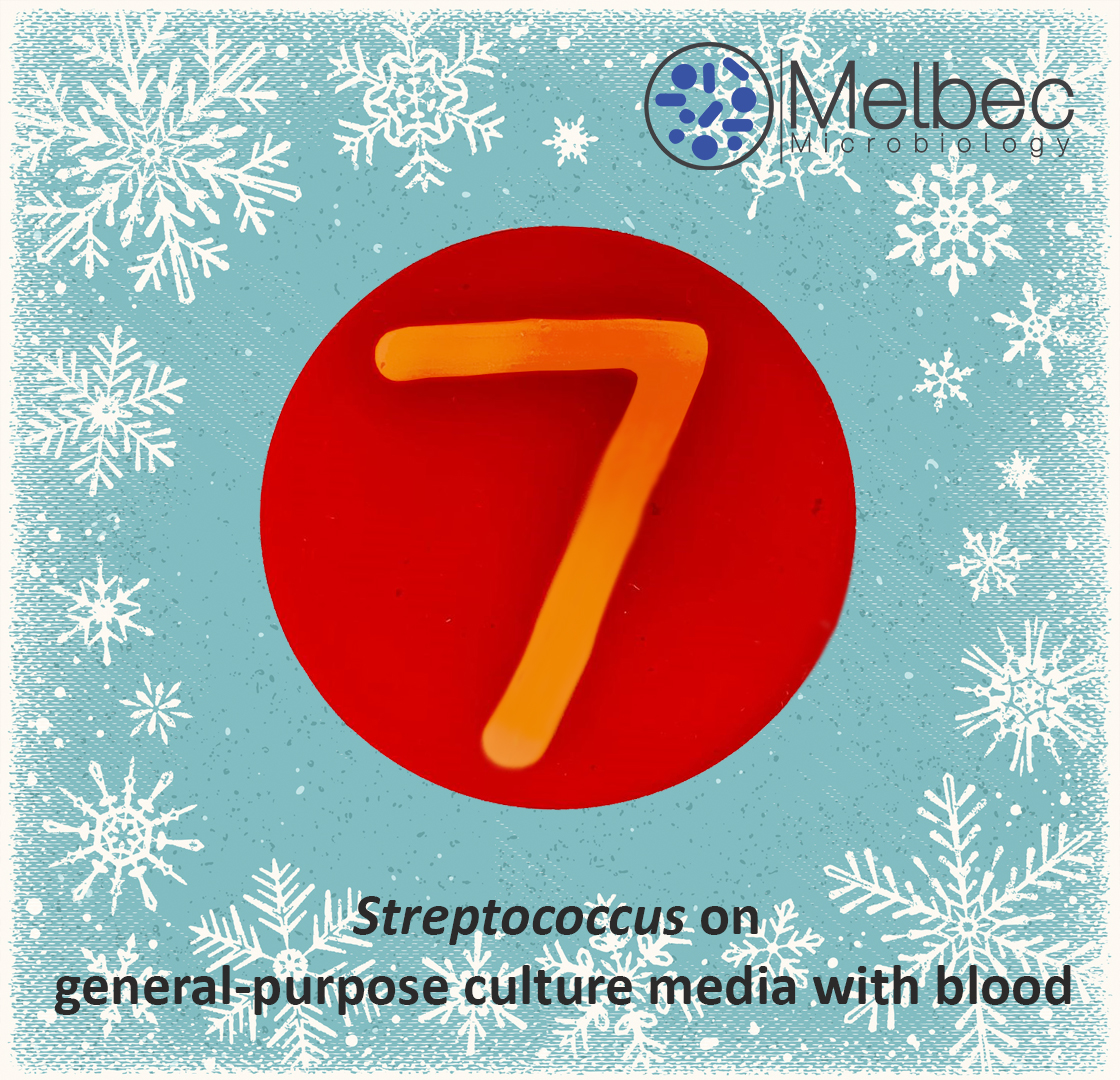
DAY 8
🎄🎁 Welcome to day 8 of December! Today’s plate is Staphylococcus epidermidis on Tryptone Soya Agar (TSA)! 🎄🎁
Staphylococcus epidermidis is a Gram-positive bacteria that is part of the human microbiota, and typically can be found on the skin. It does not normally cause infections, however, can be pathogenic to those with a weakened immune system and therefore, infections are usually hospital-acquired.
Bacteria of this kind, alongside many others, can be cultured using a general-purpose media such as Tryptone Soya Agar (TSA), which contains casein and soyabean digests that are highly nutritious and provide a nitrogen source in the form of amino acids.
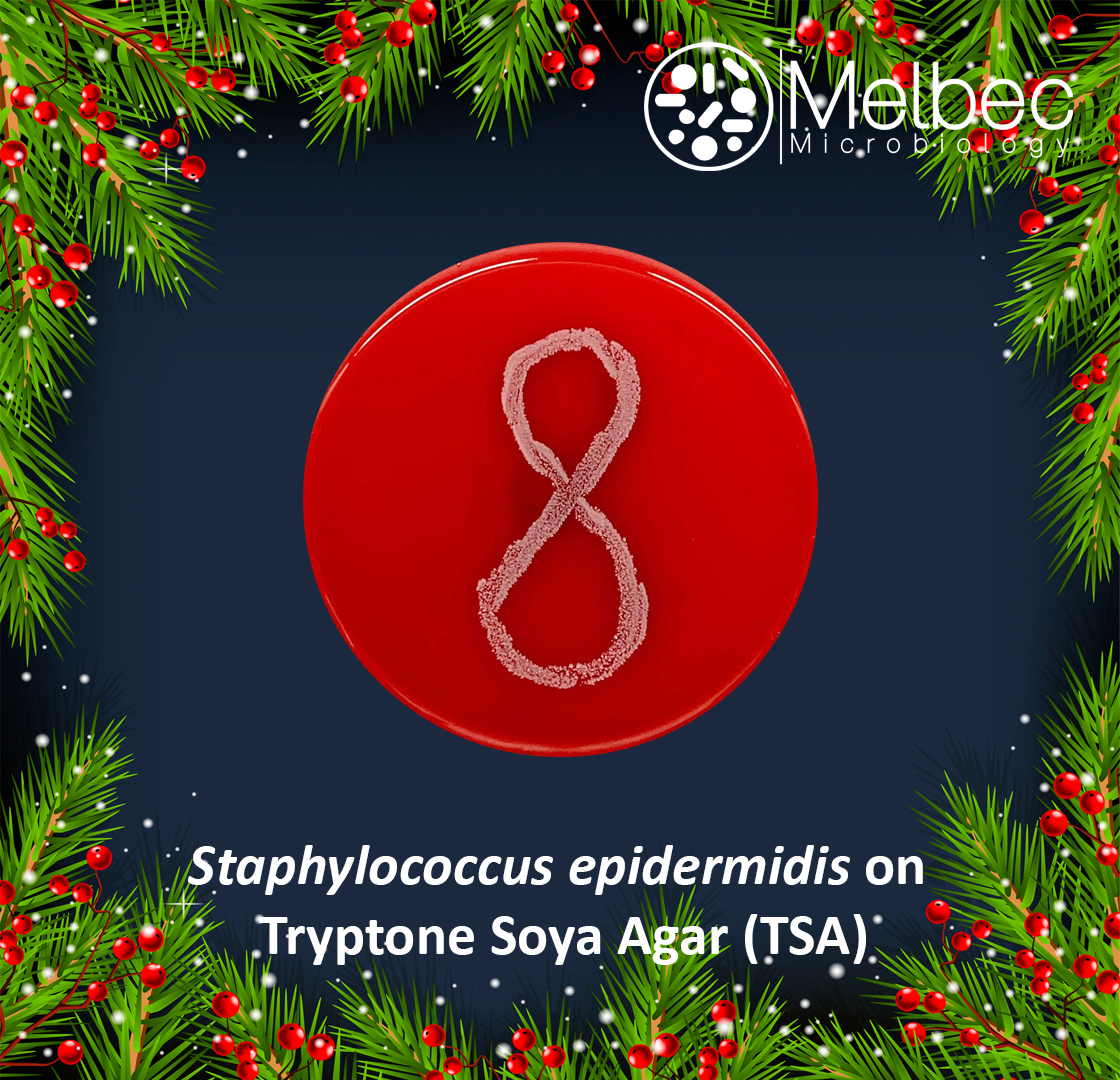
DAY 9
🎄🎁Happy Friday and it’s Day 9 of December! 🎄🎁
Today’s plate is Bacillus cereus on Mannitol Egg Yolk Polymyxin Agar (MYP)!
Bacillus cereus is an organism commonly found in places such as soil and food. The term cereus (meaning waxy in Latin) refers to its appearance when grown on blood agar. Bacillus cereus has been recognised as a causative agent of food poisonings since the 1950s, occurring when endospores survive within infected food that is not cooked properly.
Mannitol Egg Yolk Polymyxin Agar (MYP) is an effective selective and differential agar medium used to isolate Bacillus cereus species.
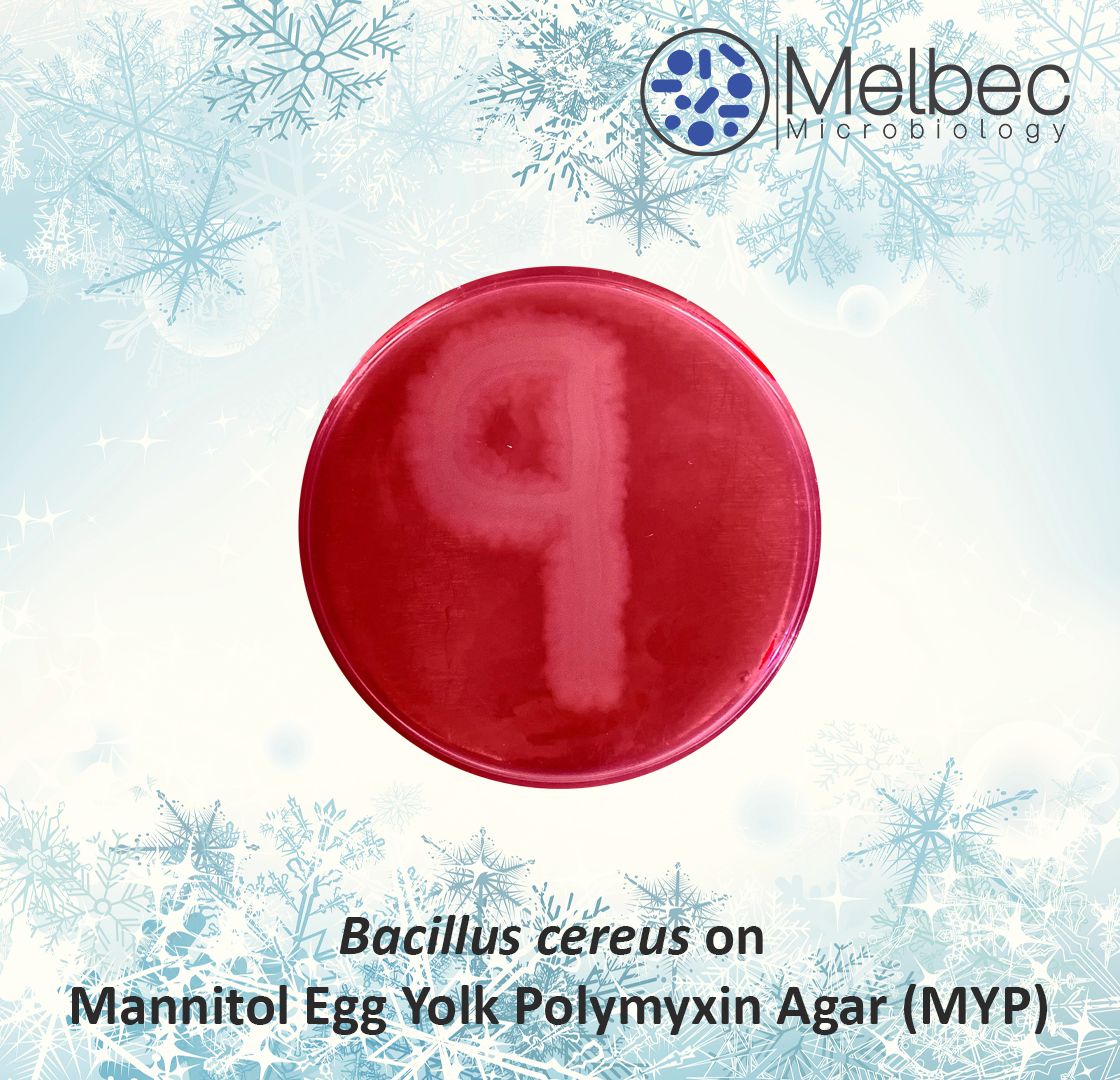
DAY 10
🎄🎁Day 10: Candida albicans on Potato Dextrose Agar (PDA)🎄🎁
Candida albicans is a yeast that is a common member of the gut flora. It is often detected in the gastrointestinal tract and in the mouth of 40 – 60% of healthy adults. It is usually a commensal organism but can be an opportunistic pathogen to those who are immunocompromised, causing fungal infections such as oral candidiasis, or thrush.
Potato Dextrose Agar (PDA) is the most commonly used medium to grow fungi, with potatoes and dextrose providing the nutrients.

DAY 11
🎄🎁Day 11: Staphylococcus aureus on Mannitol Salt Agar (MSA)!🎄🎁
Staphylococcus aureus is a Gram-positive bacteria frequently found on the skin and in the upper respiratory tract of humans. Infections of the skin such as abscesses, and respiratory infections like sinusitis are commonly caused by Staphylococcus. Methicillin-resistant S. aureus (MRSA) is an antibiotic resistant strain of the organism associated with healthcare associated infections.
Mannitol Salt Agar (MSA) is a selective and differential agar medium designed to identify the growth of Staphylococcus species. It contains high levels of salt, mannitol, and phenol red, which helps to indicate if S. aureus is present as the organism will turn the media yellow when it is grown.
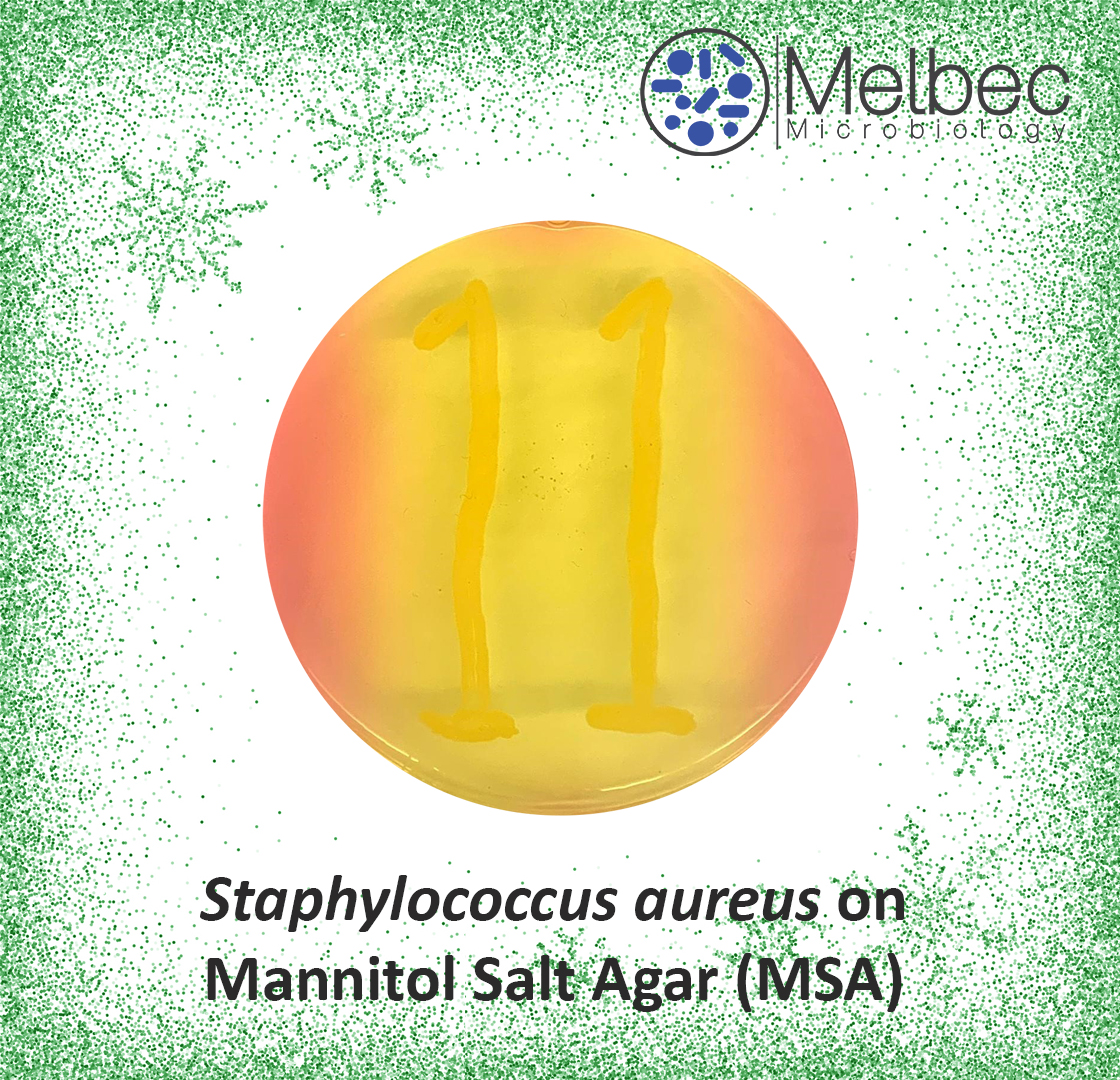
DAY 12
🎄🎁Day 12: Norovirus🎄🎁
Noroviruses belong to the family Caliciviridae, a group of non-enveloped, single-stranded RNA viruses that primarily cause acute gastroenteritis (inflammation of the stomach and/or intestines), hence why Norovirus is often referred to as the “winter vomiting bug”. Noroviruses are usually transmitted directly from person to person, or indirectly via contaminated water or food. They are extremely contagious and have been the cause of many outbreaks over the years, including in a school in Norwalk, Ohio in 1968. Noroviruses were previously called Norwalk or Norwalk-like viruses as a result.
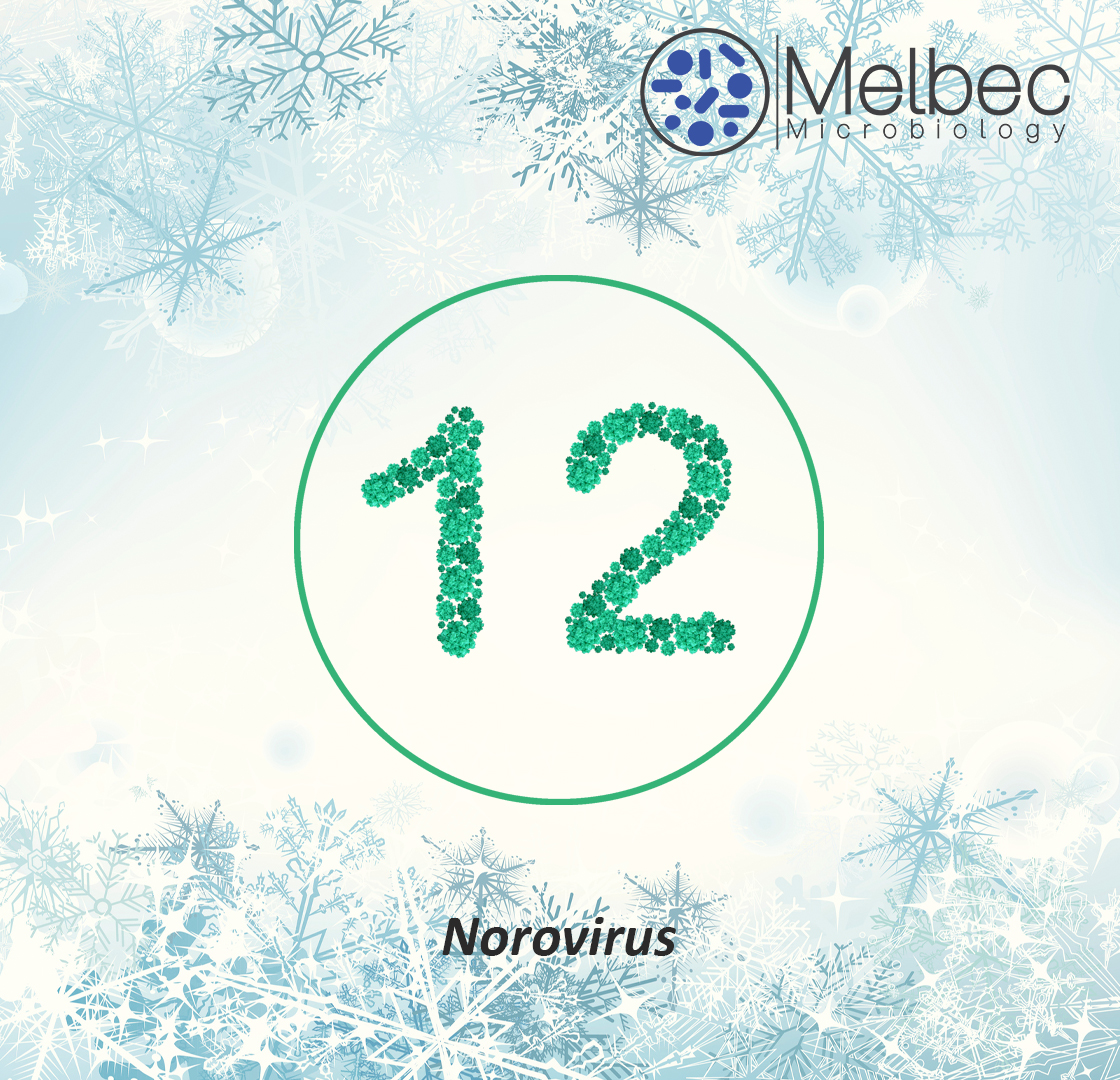
DAY 13
🎄🎁Welcome to Day 13 of December! 🎄🎁
Today’s plate is Escherichia coli on Cystine-Lactose-Electrolyte-Deficient Agar (CLED)!
Escherichia coli, a Gram-negative bacteria, is commonly found in the gut and is the cause of 75 – 95% of UTIs.
Cystine–Lactose–Electrolyte-Deficient agar (CLED) is a differential agar often used to identify and isolate bacteria from urine. It supports the growth of urinary pathogens, but prevents swarming of Proteus spp., due to its lack of electrolytes. Bromothymol blue is an indicator used in the medium, which turns yellow in the presence of acid producing organisms during lactose fermentation, whereas alkalinisation causes deep blue colonies to appear, distinguishing organisms from each other.
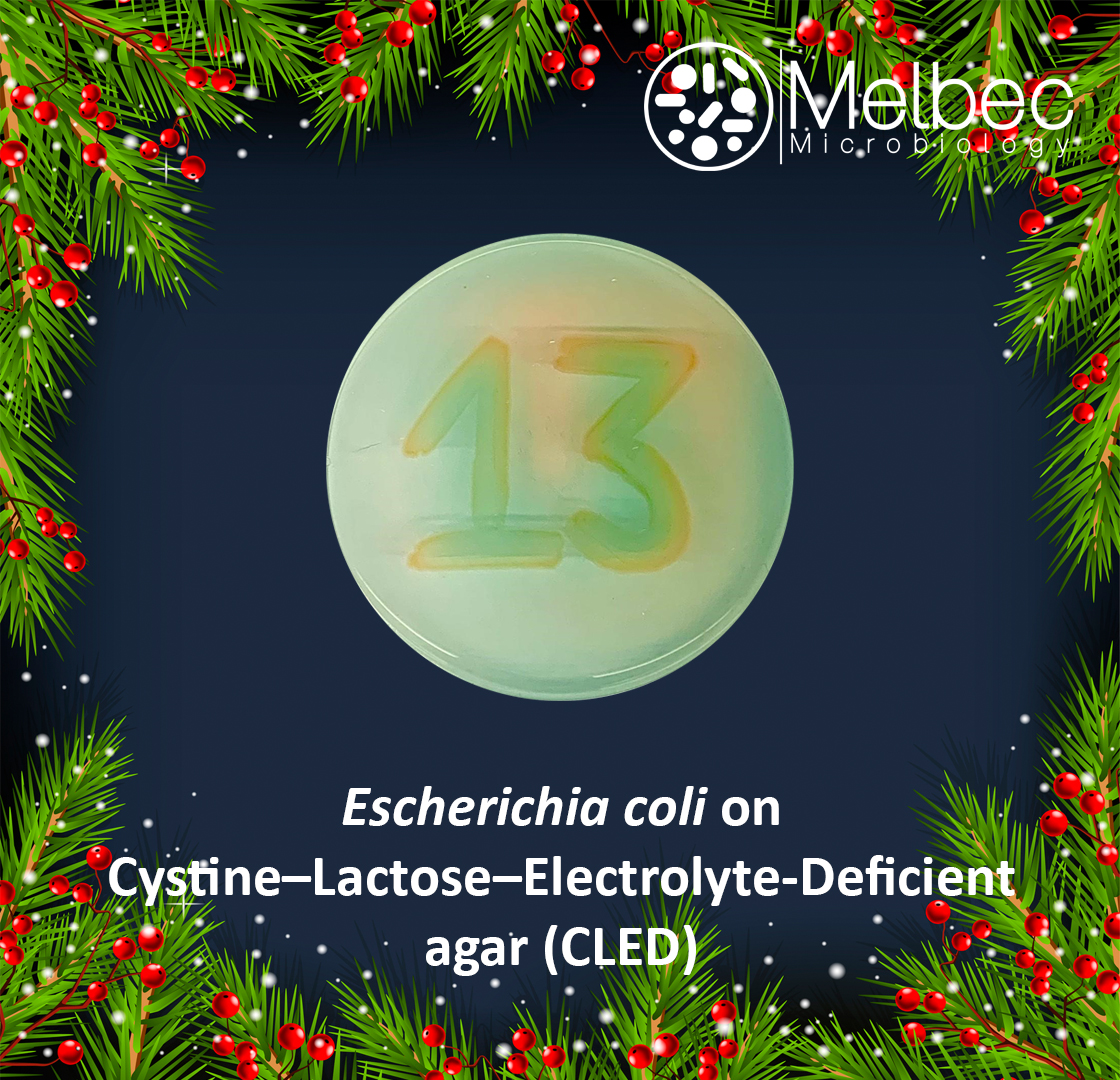
DAY 14
🎄🎁Day 14: Enterococcus on Slanetz and Bartley Agar!🎄🎁
Enterococcus are bacteria found in the faeces of most humans and many animals. It can cause infections including UTIs, wound infections, meningitis, and endocarditis. As Enterococcus is present in the faeces of animals, it is often found as a contaminant of water.
Slanetz and Bartley agar is a medium that is used to enumerate Enterococci from water samples, often using a membrane filtration technique. Dark red or maroon colonies will appear on the surface of the agar, but these are not exclusive to Enterococci alone, therefore further identification is required to confirm the presence of the organism.
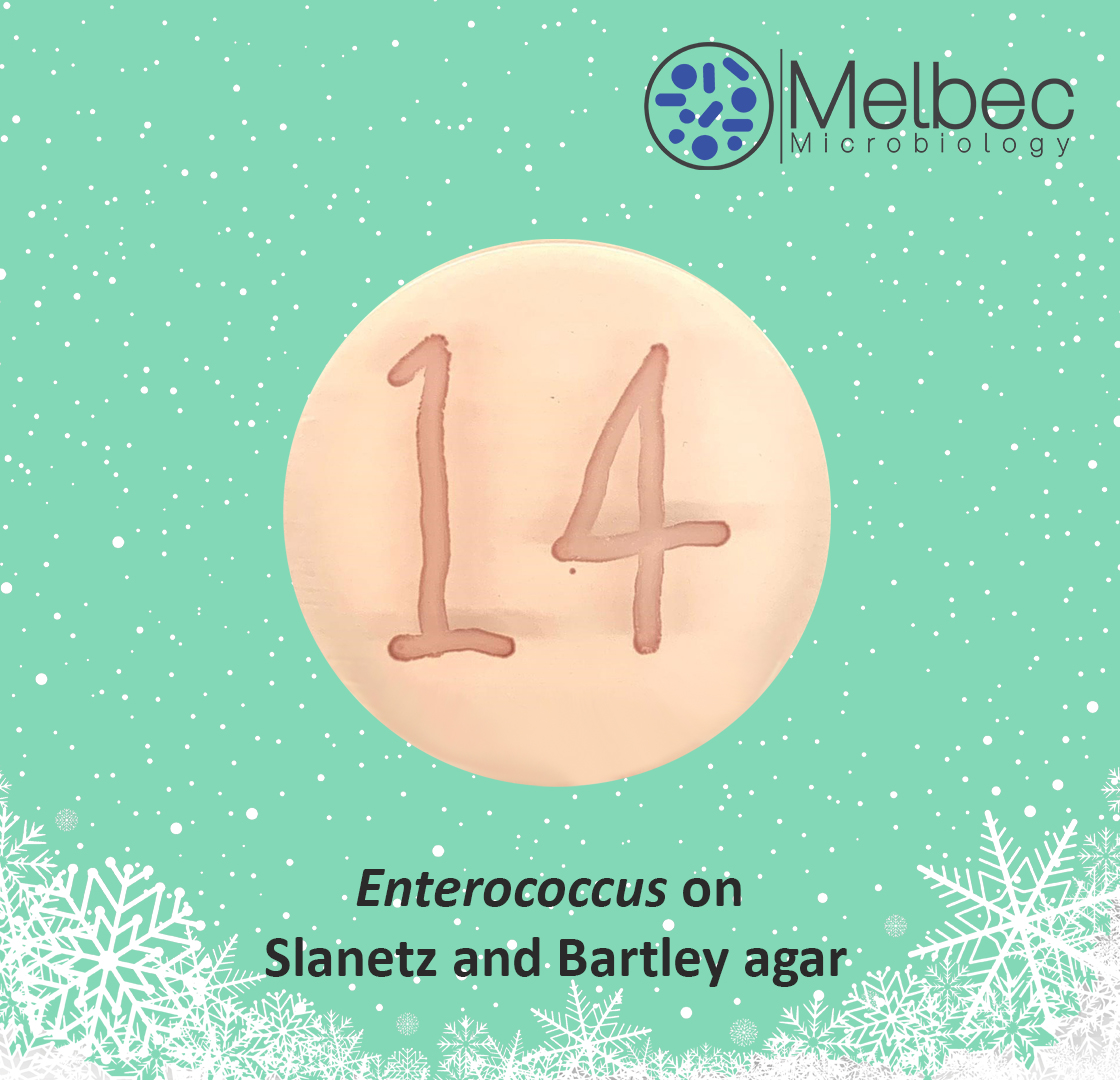
DAY 15
🎄🎁Welcome to Day 15: Staphylococcus aureus on CLED!🎄🎁
Staphylococcus aureus is a common skin organism associated with the skin flora of humans; however it can also be an opportunistic pathogen causing infections, including those resistant to antibiotics (MRSA).
Cystine-Lactose-Electrolyte-Deficient Agar (CLED) is a differential culture medium used in isolating bacteria from urine, supporting growth of a wide range of pathogens. On CLED, S. aureus appears yellow in colour as it produces acid when it grows, which changes the colour of the indicator within the media.
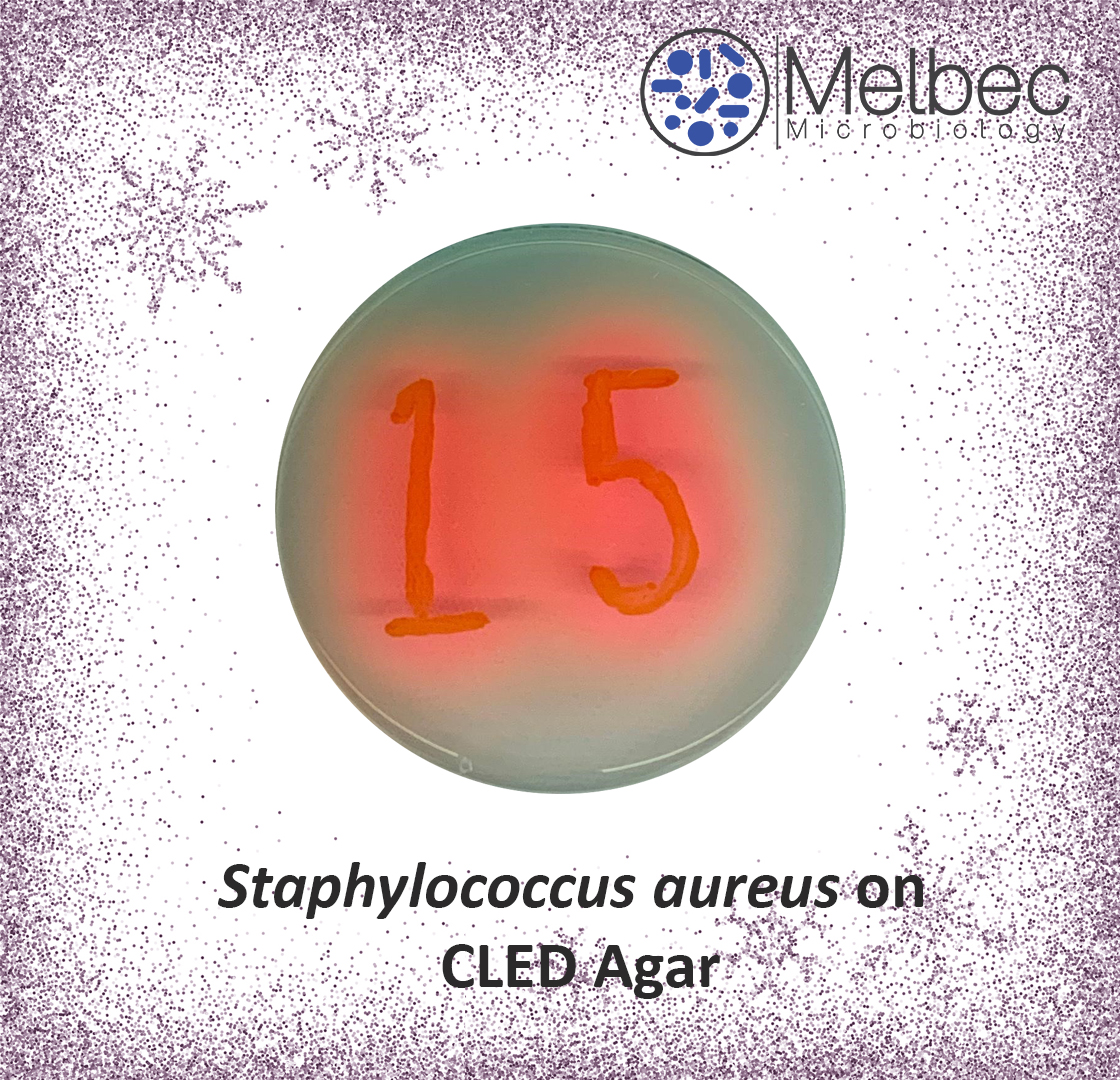
DAY 16
🎄🎁Happy Friday and welcome to Day 16 of December! Today’s plate is Pluralibacter gergoviae on MLGA!🎄🎁
Pluralibacter gergoviae is a Gram-negative bacterium that has been isolated from soil, water, sewage, and many other sources, and is known as an opportunistic pathogen that can cause harm to humans. It is of particular interest to the cosmetics industry, as it often shows resistance to parabens, a common preservative used in many cosmetic products.
Membrane Lactose Glucuronide Agar (MLGA) is a differential medium designed to identify bacterial contamination from water samples including E. coli and coliforms, usually using the membrane filtration technique.
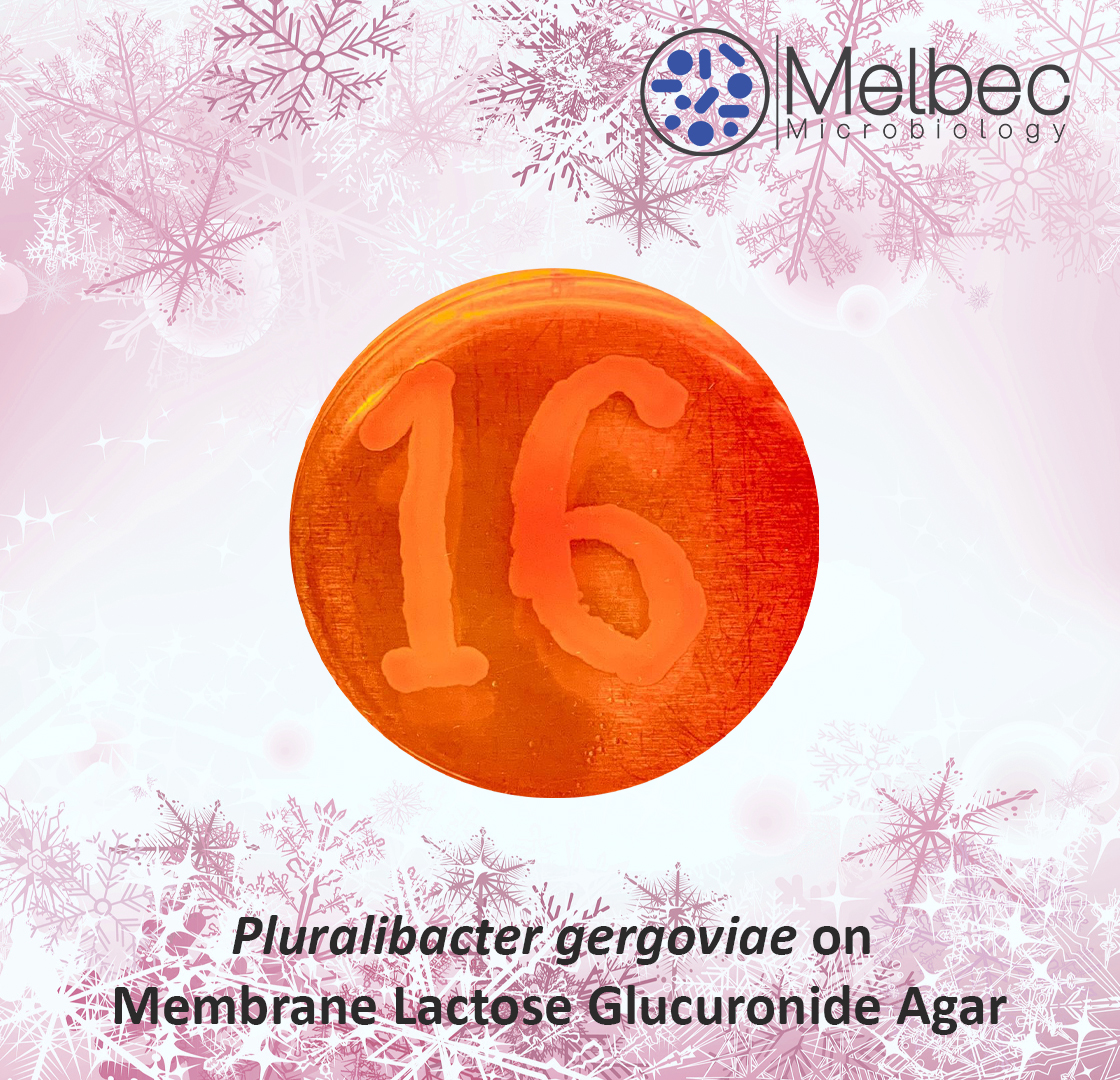
DAY 17
🎄🎁Day 17: Serratia on TSA!🎄🎁
Serratia is a genus of Gram-negative facultative anaerobic rod-shaped bacteria. Various strains of Serratia can be found within natural habitats such as soil, water, and plants. S. marcescens, the most common species, was first discovered when, during the summer of 1819 in Padura, Italy, the town people discovered that their polenta dish turned red. At first, the people believed that this incident was caused by the devil, and it wasn’t until the 1970’s when S. marcescens was confirmed as a human pathogen.
On Tryptone Soya Agar (TSA), S. marcescens grows bright, glossy red colonies.
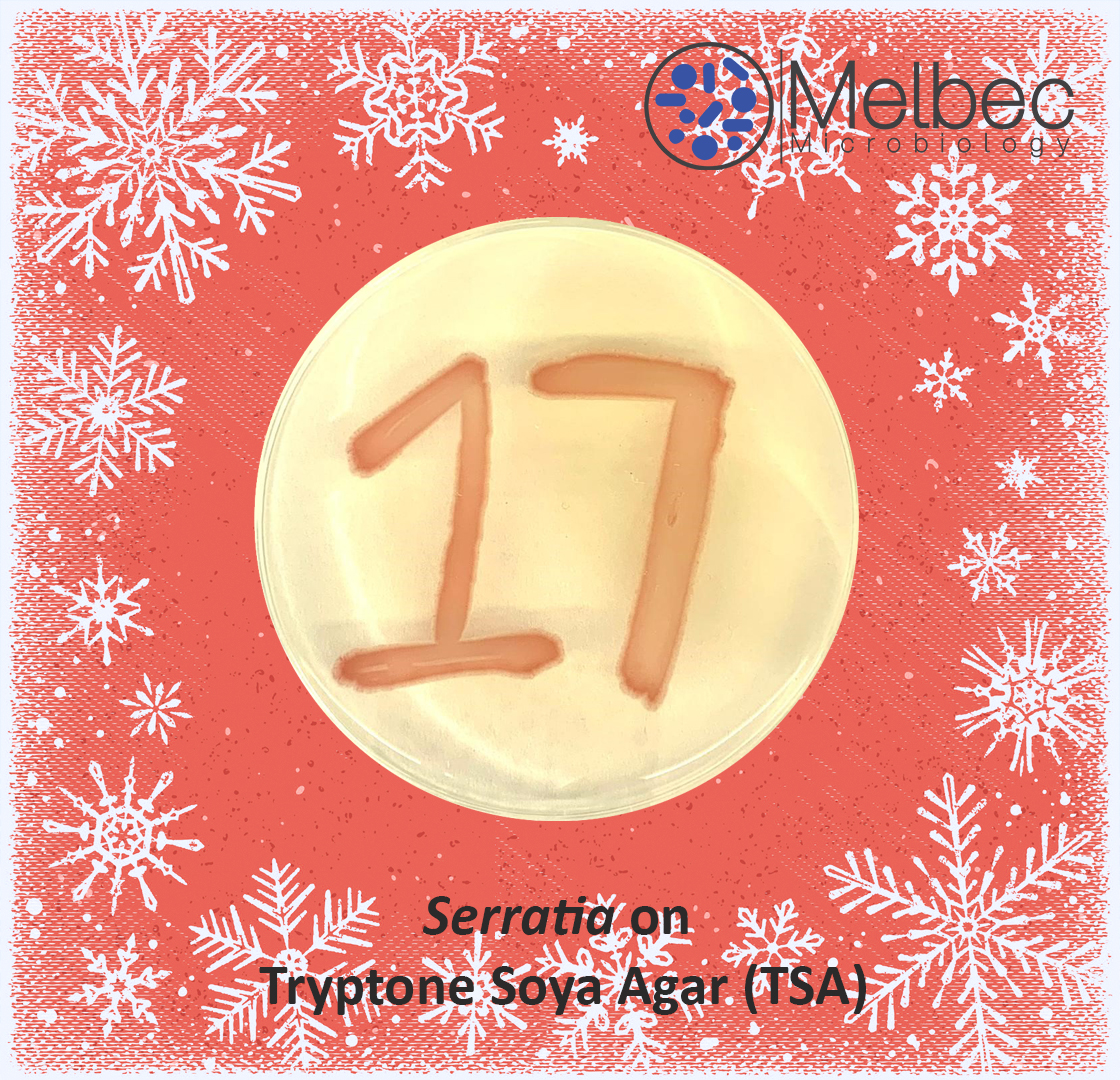
DAY 18
🎄🎁Day 18: E.coli on Tryptone Bile Glucuronide Agar!🎄🎁
E. coli, a common pathogen, can be isolated using Tryptone Bile Glucuronide Agar (TBGA, or TBX), a selective, chromogenic medium used for the detection and growth of E. coli found in food and animal feed. It contains tryptone, bile salts, and X-glucuronide, a chromogenic agent that helps to distinguish most E. coli strains from other coliforms. During growth, E. coli will absorb the glucuronide produced and produce blue/green colonies when grown.
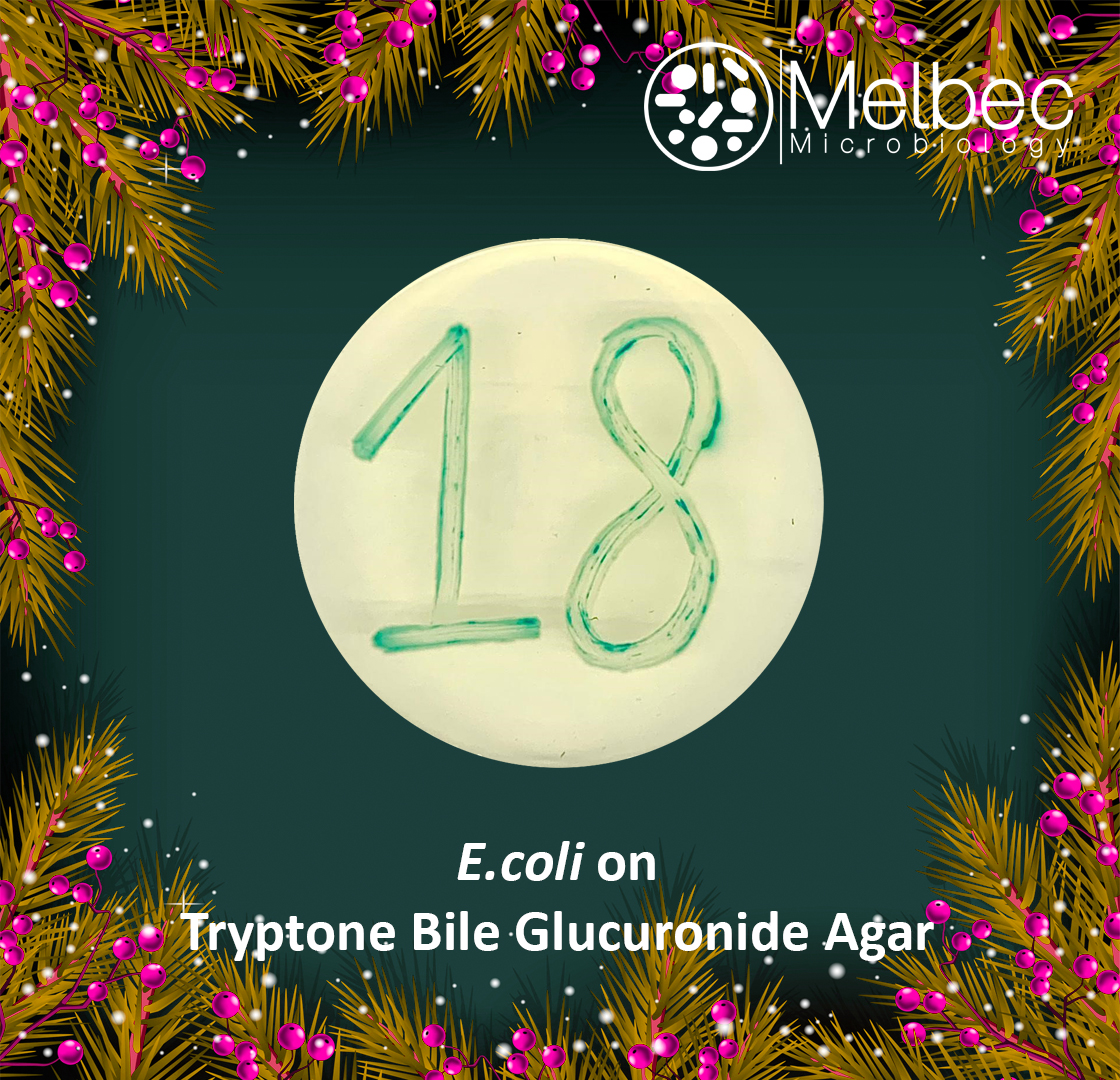
DAY 19
🎄🎁Day 19: Influenza H1N1🎄🎁
The influenza A virus (H1N1) is part of the Orthomyxoviridae family and is a single-stranded RNA enveloped virus ranging from 80-120 nm in diameter. It has been associated with major outbreaks of infection in humans, including the Spanish flu, the 1977 Russian flu pandemic, and most recently, the 2009 swine flu pandemic. It became known as swine flu because it’s similar to flu viruses that affect pigs. It is now a type of seasonal flu and is included in the annual flu vaccine.

DAY 20
🎄🎁Welcome to Day 20 of December, only 5 days until Christmas!! Today’s plate is Candida albicans on MEA!🎄🎁
Candida albicans is a yeast that is usually found within the normal gut and mouth flora of humans but can also be attributed to the fungal infection candidiasis.
Malt Extract Agar (MEA) is a general growth media specifically designed to facilitate the growth of fungal strains, in particular yeasts. The media is altered to pH 5.4 using lactic acid, intended to suppress the growth of bacterial strains.
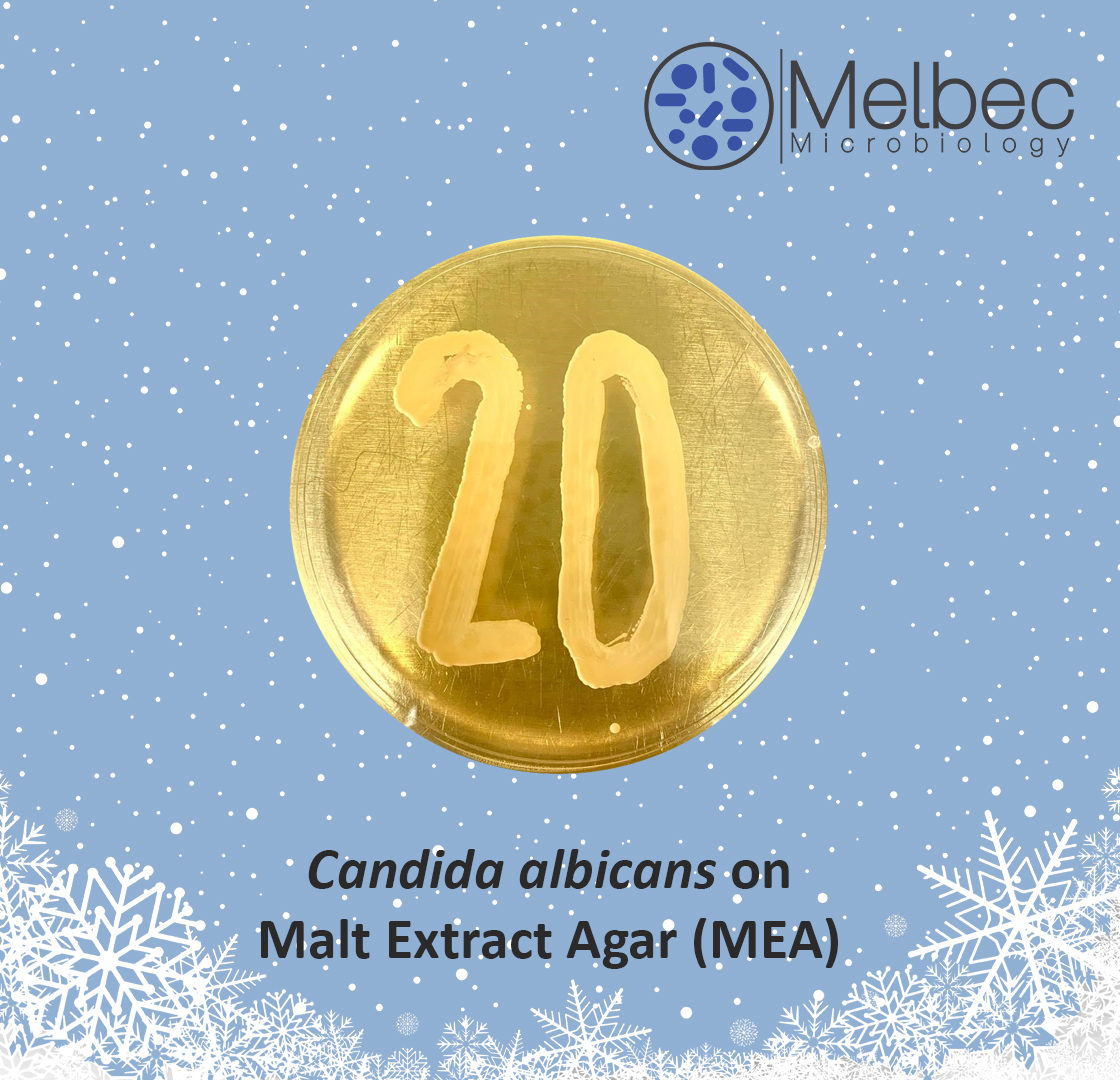
DAY 21
🎄🎁Only 4 days until Christmas! Today’s plate is Methicillin-resistant Staphylococcus aureus on TSA!🎄🎁
Methicillin-resistant Staphylococcus aureus (MRSA) is an antibiotic resistant strain of S. aureus organism, which is commonly referred to as a “superbug” due to its resistance to several widely used antibiotics. MRSA can live harmlessly on the skin and is carried by around 1 in 30 people.
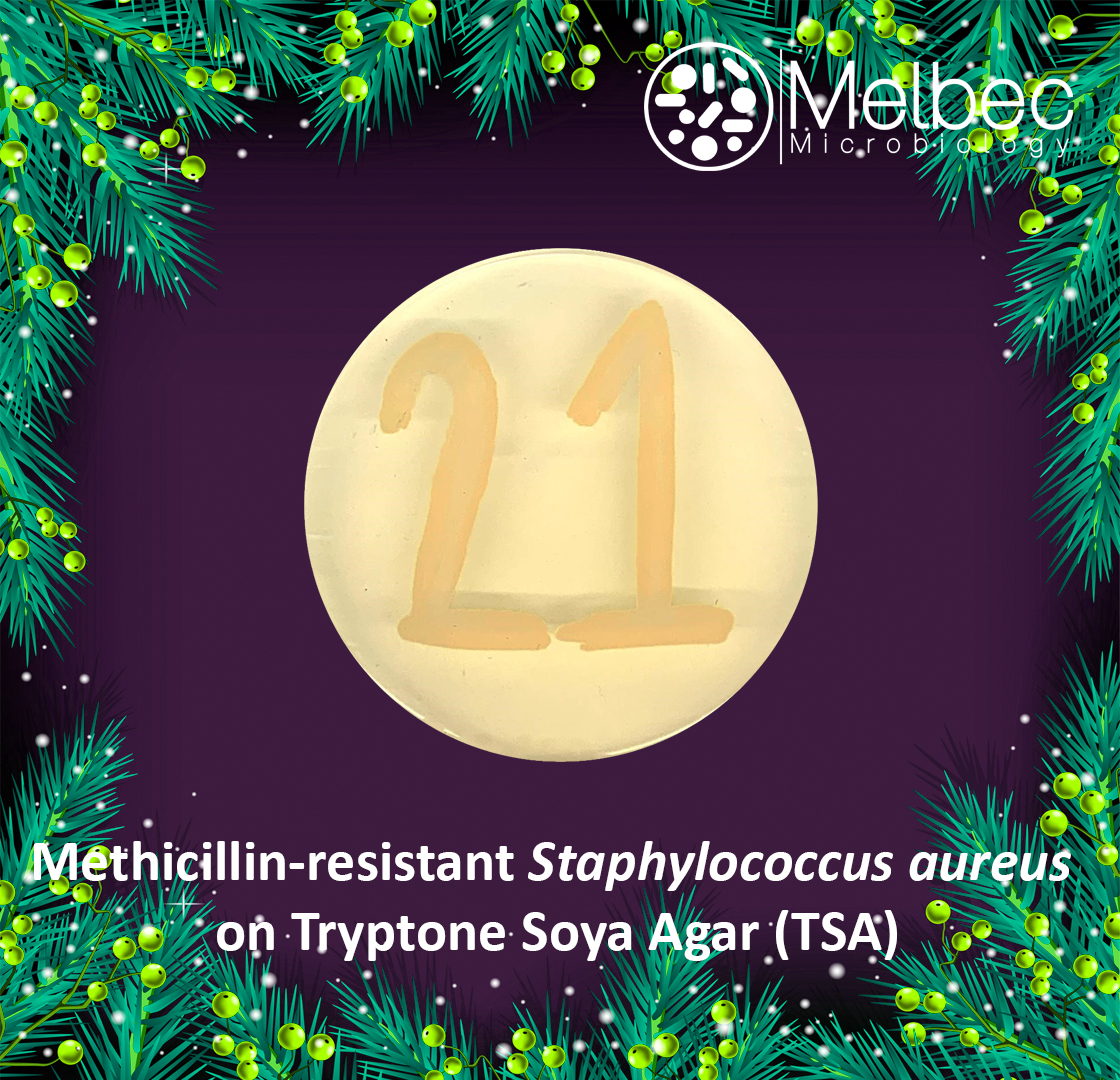
DAY 22
🎄🎁Day 22: Salmonella on XLD!🎄🎁
Salmonella is a genus of rod-shaped bacteria, which are predominantly motile and contain flagella to help them move. Salmonella spp. are commonly associated with food poisoning, as they often cause illness to humans when they are ingested through contaminated food.
Xylose Lysine Deoxycholate agar (XLD) is a selective growth medium used in the isolation of Salmonella and Shigella species from clinical samples and from food. Typically, Salmonella spp. produce red colonies, some with black centres, on this agar type.
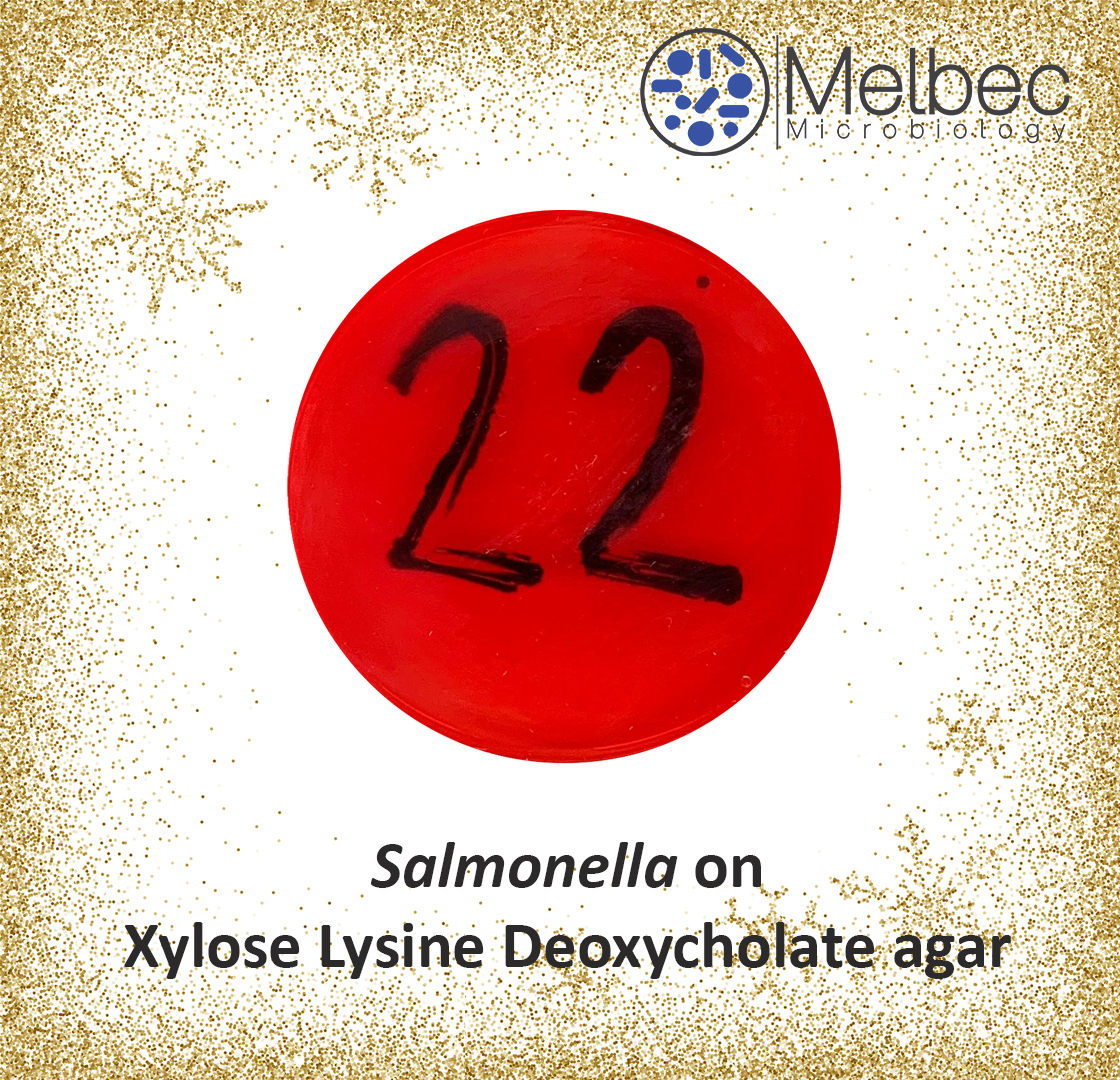
DAY 23
🎄🎁Happy Friday and welcome to Day 23 of December, only 2 days to go until Christmas!! Today’s plate is Listeria on Listeria!🎄🎁
Listeria is a genus of bacteria named after the British surgeon Joseph Lister. Listeria causes serious infection and illness to humans, usually caused by eating food contaminated with the bacterium Listeria monocytogenes. An estimated 1,600 people get listeriosis each year, and about 260 die. The infection is most likely to sicken pregnant women and their newborns, adults aged 65 or older, and people with weakened immune systems.
Listeria agar base can be used as a selective medium to isolate for Listeria spp.
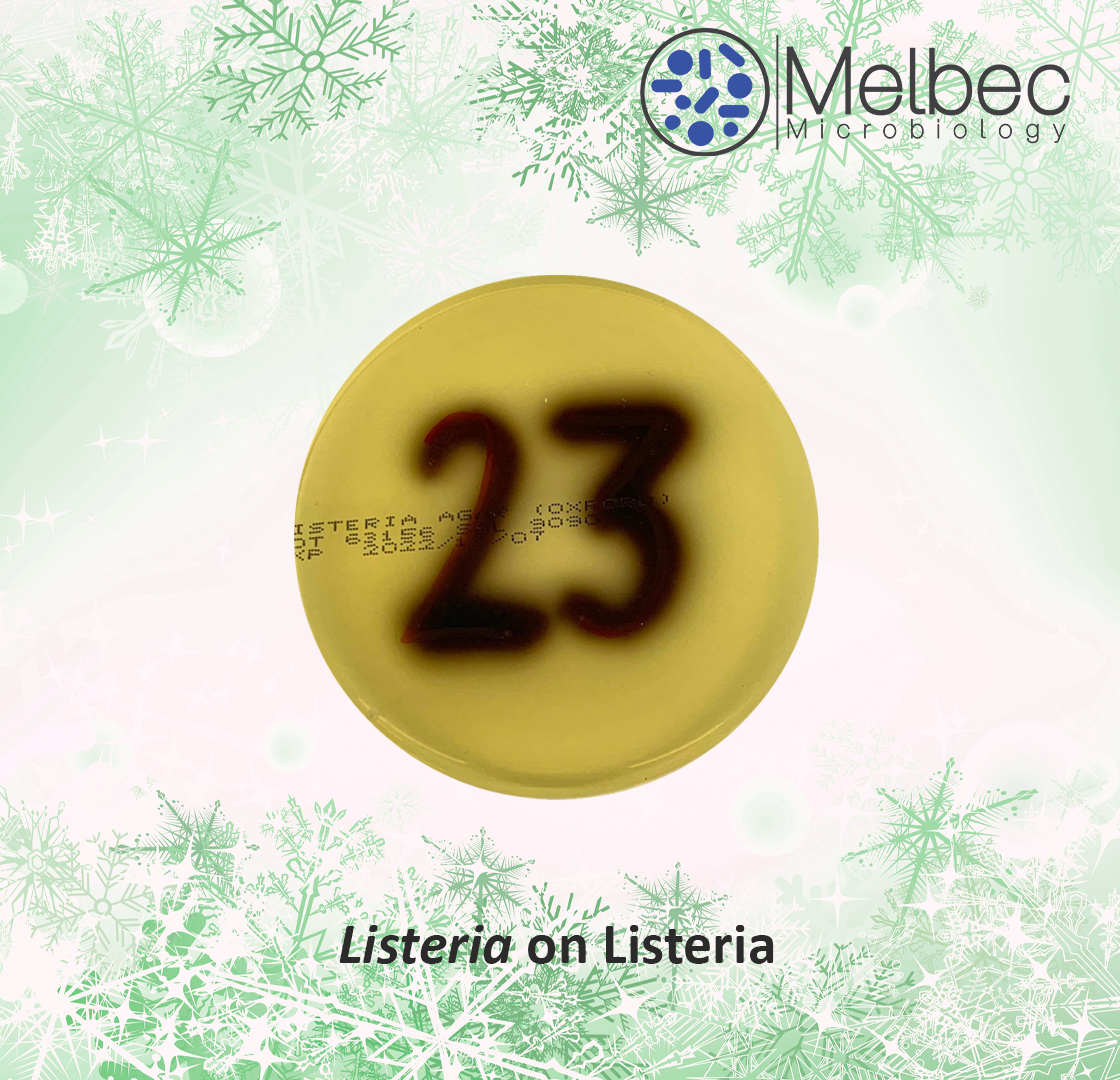
DAY 24
🎄🎁Welcome to Day 24 of December and our last plate is Clostridium perfringens on TSC!🎄🎁
Clostridium perfringens is a Gram positive, spore forming bacteria that is one of the most common causes of food poisoning. It has the shortest reported generation time of any organism, and for that reason, food poisoning from C. perfringens can show symptoms as early as 6 hours after ingestion.
Tryptone Sulphite Cycloserine (TSC) agar can be used for the presumptive identification and enumeration of Clostridium perfringens, producing black coloured colonies with an opaque halo.
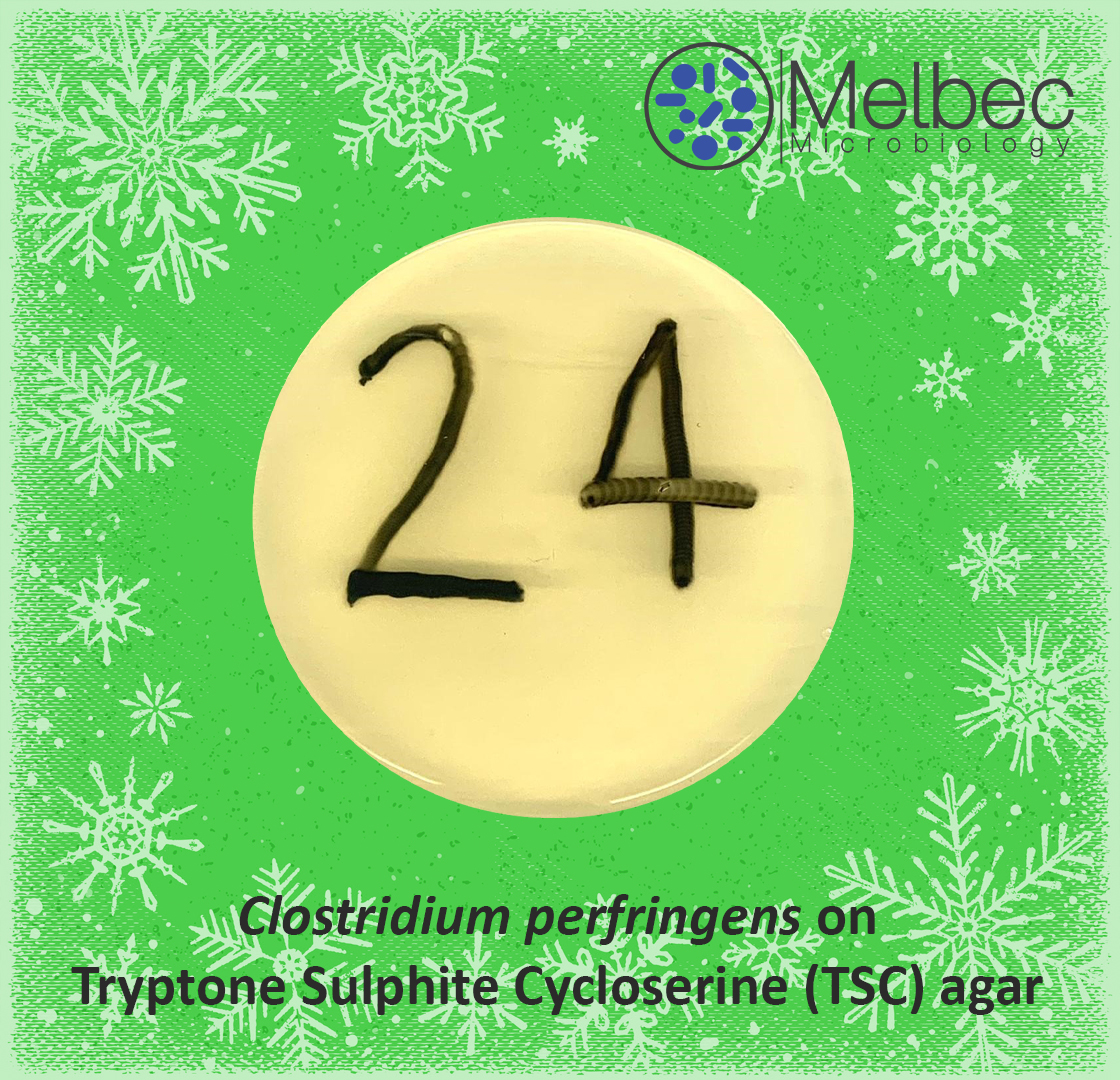
We hope you liked our microbiology advent calendar, follow us on social media and keep an eye out for more exciting posts!